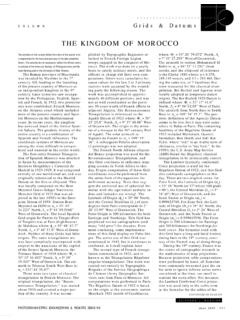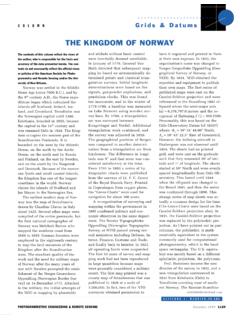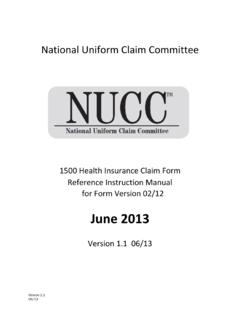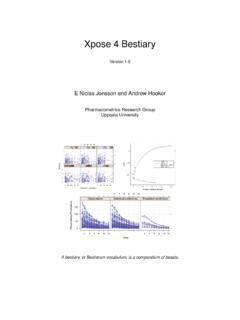Transcription of LAS SPECIFICATION VERSION 1.4 – R13 15 July 2013
1 American Society for Photogrammetry & Remote Sensing Page 1 of 28 LAS SPECIFICATION VERSION LAS SPECIFICATION VERSION R13 15 July 2013 Approved: November 2011 Published by: The American Society for Photogrammetry & Remote Sensing 5410 Grosvenor Lane, Suite 210 Bethesda, Maryland 20814-2160 Voice: 301-493-0290 Fax: 301-493-0208 Web: All rights reserved. Copyright 2002-2011 American Society for Photogrammetry and Remote Sensing (ASPRS). All rights reserved. Permission to Use: The copyright owner hereby consents to unlimited use and distribution of this document, or parts thereof, as a SPECIFICATION provided such use references ASPRS as the publisher. This consent does not extend to other uses such as general distribution in any form, including electronic, by any individual or organization whether for advertising or promotional purposes, for creating new collective works, or for resale.
2 For these and all other purposes, reproduction of this publication or any part thereof (excluding short quotations for use in the preparation of reviews and technical and scientific papers) may be made only after obtaining the specific approval of the publisher. Printed in the United States of America. American Society for Photogrammetry & Remote Sensing Page 2 of 28 LAS SPECIFICATION VERSION REVISION HISTORY R11 - Approved VERSION (Nov 2011) R12 - Errata (June 2012) - Typographical Corrections Corrected Public Header size in descriptive paragraph to 375 bytes Corrected two instances of Scan Angle Rank from "Unsigned Char" to "Char" R13 - Added Domain Profile Section (July 2013) LAS FORMAT VERSION : 1 Purpose, scope, and applicability The LAS file is intended to contain LIDAR (or other) point cloud data records.
3 The data will generally be put into this format from software ( provided by LIDAR hardware vendors) which combines GPS, IMU, and laser pulse range data to produce X, Y, and Z point data. The intention of the data format is to provide an open format that allows different LIDAR hardware and software tools to output data in a common format. This document reflects the fourth revision of the LAS format SPECIFICATION since its initial VERSION release. THE ADDITIONS OF LAS INCLUDE: Backward compatibility with LAS LAS when payloads consist of only legacy content LAS Mode which supports o Extension of offsets and field sizes to support full 64 bit o Support for up to 15 returns per outgoing pulse o Extension of the Point Class field to support 256 classes o Definition of several new ASPRS standard classes o Extension of the Scan Angle field to 2 bytes to support finer angle resolution o Addition of a Sensor Channel bit field to support mobile mapping systems o Addition of Well Known Text (WKT) definitions for Coordinate Reference Systems o Addition of an Overlap bit to allow indicating pulses in the overlap region while maintaining the class definition o Addition of an (optional)
4 Extra Byte Variable Length Record to describe "extra bytes" stored with each point Other minor changes o Added definitions for LAS Domain Profile and LAS Domain Profile Description American Society for Photogrammetry & Remote Sensing Page 3 of 28 LAS SPECIFICATION VERSION 2 Conformance The data types used in the LAS format definition are conformant to the 1999 ANSI C Language SPECIFICATION (ANSI/ISO/IEC 9899:1999 ("C99"). 3 Authority The American Society for Photogrammetry & Remote Sensing (ASPRS) is the owner of the LAS SPECIFICATION . The standard is maintained by committees within the organization as directed by the ASPRS Board of Directors. Questions related to this standard can be directed to ASPRS at 301-493-0290, by email at or by mail at 5410 Grosvenor Lane, Suite 210, Bethesda, Maryland 20814-2160.)
5 4 Requirements LAS FORMAT DEFINITION: The format contains binary data consisting of a public header block, any number of (optional) Variable Length Records (VLRs), the Point Data Records, and any number of (optional) Extended Variable Length Records (EVLRs). All data are in little-endian format. The public header block contains generic data such as point numbers and point data bounds. We refer to the data content of the file as the payload. The Variable Length Records (VLRs) contain variable types of data including projection information, metadata, waveform packet information, and user application data. They are limited to a data payload of 65,535 bytes. The Extended Variable Length Records (EVRLs) allow a higher payload than VLRs and have the advantage that they can be appended to the end of a LAS file. This allows adding, for example, projection information to a LAS file without having to rewrite the entire file.
6 Table 1: LAS Format Definition PUBLIC HEADER BLOCK VARIABLE LENGTH RECORDS (VLR)POINT DATA RECORDS EXTENDED VARIABLE LENGTH RECORDS (EVLR) A LAS file that contains point record types 4, 5, 9, or 10 could potentially contain one block of waveform data packets that is stored as the payload of any Extended Variable Length Record (EVLR). Unlike other EVLRs, the Waveform Data Packets (if stored internally to the file) have the offset to the storage header contained within the Public Header Block ( Start of Waveform Data Packet Record ). LEGACY COMPATIBILITY (LAS LAS ): LAS moves the file SPECIFICATION from a 32 bit file structure (maximum value of 232 1 == 4,294,967,295 == UINT32_MAX) to a 64 bit file structure (264 1). To maintain the ability to place a LAS through LAS payload (point record types 0-5, GeoTIFF coordinate reference system, referred to as Legacy payloads) in a LAS file structure, it was necessary to duplicate some of the fields within the LAS file structure.
7 These duplicate fields are named Legacy xxx where xxx denotes the meaning of the field. American Society for Photogrammetry & Remote Sensing Page 4 of 28 LAS SPECIFICATION VERSION A LAS file writer who wishes to maintain backward compatibility must maintain both the legacy fields and the equivalent non-legacy fields in synchronization. Of course, this is not possible if the number of points exceeds UINT32_MAX, in which case the legacy fields must be set to zero. If a file writer is not maintaining backward compatibility, the legacy fields must always be set to zero. If there is a discrepancy between a non-zero legacy field and the equivalent LAS field, the LAS reader should use the legacy value to maintain the same behavior as a LAS through LAS reader. Best practice is to also throw an informative error so that the file can be repaired.
8 COORDINATE REFERENCE SYSTEM (CRS) REPRESENTATION: GeoTIFF is being replaced by Well Known Text (WKT) as the required Coordinate Reference System (CRS) representation for the new point types (6-10) introduced by LAS GeoTIFF is maintained for legacy reasons for point types 0-5. A WKT bit has been added to the Global Encoding flag in the Public Header Block. If this bit is set, the CRS for the file will be located in the WKT (Extended) Variable Length Records (EVLR, VLR). A file writer who desires to maintain backward compatibility with legacy LAS for point types 0-5 must add a GeoTIFF VLR to represent the CRS for the file and ensure that the WKT bit is false. The CRS representation is summarized in Table 2 Table 2: Coordinate Reference System Representation Point Type WKT bit == FalseWKT bit == True0-5 GeoTIFF WKT6-10 Error WKT It is considered a file error to have more than one GeoTIFF (E)VLR or more than one WKT (E)VLR in the file.
9 A writer can append a new CRS EVLR to a file by superseding the existing CRS (E)VLR. Superseding is performed by changing the LAS_Spec ID of the record to Superseded , a new LASF_Spec defined in this release. DATA TYPES: The following data types are used in the LAS format definition. Note that these data types are conformant to the 1999 ANSI C Language SPECIFICATION (ANSI/ISO/IEC 9899:1999 ("C99"). char (1 byte) unsigned char (1 byte) short (2 bytes) unsigned short (2 bytes) long (4 bytes) unsigned long (4 bytes) long long (8 bytes) unsigned long long (8 bytes) float (4 byte IEEE floating point format) double (8 byte IEEE floating point format) string (a variable series of 1 byte characters, ASCII encoded, null terminated) American Society for Photogrammetry & Remote Sensing Page 5 of 28 LAS SPECIFICATION VERSION PUBLIC HEADER BLOCK: Table 3.)
10 Public Header Block Item FormatSize RequiredFile Signature ( LASF ) char[4]4 bytes * File Source ID unsigned short2 bytes * Global Encoding unsigned short2 bytes * Project ID - GUID data 1 unsigned long4 bytes Project ID - GUID data 2 unsigned short2 byte Project ID - GUID data 3 unsigned short2 byte Project ID - GUID data 4 unsigned char[8]8 bytes VERSION Major unsigned char1 byte * VERSION Minor unsigned char1 byte * System Identifier char[32]32 bytes * Generating Software char[32]32 bytes * File Creation Day of Year unsigned short2 bytes * File Creation Year unsigned short2 bytes * Header Size unsigned short2 bytes * Offset to point data unsigned long4 bytes * Number of Variable Length Records unsigned long4 bytes * Point Data Record Format unsigned char1 byte * Point Data Record Length unsigned short2 bytes * Legacy Number of point records unsigned long4 bytes * Legacy Number of points by returnunsigned long [5]
















